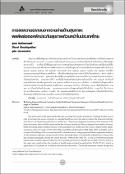บทคัดย่อ
วัตถุประสงค์ที่สำคัญของการมีหลักประกันสุขภาพถ้วนหน้าในประเทศไทยนอกจากเพื่อเพิ่มการเข้าถึงบริการสุขภาพที่จำเป็นของประชากรแล้ว การลดความเสี่ยงของครัวเรือนจากภาระค่าใช้จ่ายเมื่อเจ็บป่วยเป็นเป้าหมายที่สำคัญอีกประการหนึ่ง การศึกษานี้ใช้ข้อมูลการสำรวจภาวะเศรษฐกิจและสังคมของครัวเรือนโดยสำนักงานสถิติแห่งชาติ เพื่อประมาณการจำนวนครัวเรือนทั่วประเทศที่ยากจนเพราะรายจ่ายสุขภาพในช่วงก่อนมีหลักประกันสุขภาพถ้วนหน้า (พ.ศ.2539, 2541, 2543 และ 2545) และภายหลัง (พ.ศ.2547, 2549, 2550 และ 2551) โดยใช้ตัวแบบสมการถดถอยเชิงเส้นตรงแบบเป็นช่วง เพื่อเปรียบเทียบกับสถานการณ์หากไม่มีนโยบายดังกล่าว พบว่า สัดส่วนครัวเรือนในระดับประเทศ ภูมิภาคและจังหวัดที่ต้องตกอยู่ใต้เส้นความยากจนเนื่องจากการจ่ายค่ารักษาพยาบาลมีแนวโน้มลดลงโดยลำดับ ประมาณการได้ว่า หากไม่มีนโยบายหลักประกันสุขภาพถ้วนหน้าใน พ.ศ.2545 ครัวเรือนที่ยากจนเนื่องจากรายจ่ายด้านสุขภาพใน พ.ศ.2551 จะมีจำนวน 100,604 ครัวเรือน การมีหลักประกันสุขภาพถ้วนหน้าสามารถลดจำนวนครัวเรือนดังกล่าวลงได้จำนวน 37,628 ครัวเรือน หรือร้อยละ 37.4 ซึ่งคิดเป็นร้อยละ 0.2 ของ 19 ล้านครัวเรือนในประเทศ การออกแบบระบบประกันสุขภาพโดยคำนึงถึงด้าน ความกว้าง คือ จำนวนประชากรที่ครอบคลุม และด้านความลึก คือ ขอบเขตของสิทธิประโยชน์ มีความสำคัญต่อการป้องกันมิให้ครัวเรือนต้องตกอยู่ภายใต้กับดักความยากจนเนื่องจากภาระค่าใช้จ่ายเมื่อยามเจ็บป่วย
บทคัดย่อ
The major aims of the universal health care coverage (UC) policy initiated in Thailand in 2001 are not
only to increase the access of people to essential health services, but also to reduce the financial risk they
face due to out-of-pocket payments for health care. This study employed secondary data analysis of the
Socio-Economic Survey (SES) conducted by the National Statistical Office to estimate the number of households
becoming impoverished because of the payments for health care they had to make before implementation
of the UC policy (1996, 1998, 2000, and 2002) and thereafter (2004, 2006, 2007, and 2008), and to
compare the findings with a counter-factual UC-absent scenario, using segmented linear regression analysis.
At the national, regional, and provincial levels, the proportions of households falling below the poverty
line declined gradually during the study periods. Without the 2002-UC, a total of 100,604 households
nationwide would be impoverished by out-of-pocket payments for health care in 2008. The UC policy in
the same year could reduce the number of health-impoverished households by 37,628 (37.4%), which is
equivalent to 0.2 percent of 19 million households nationwide. The health insurance system design that takes into account both “breadth” (that is, the number of the population covered) and the benefit package’
s “depth” dimensions, provides better financial risk protection and prevents households from falling into
the poverty trap due to the necessity of making costly health expenditures


